|
|
|
|
|
Intel Core 2 Duo "Conroe" CPUs |
|
Join the community - in the OCAU Forums!
|
Power Consumption, Heat Output, Overclocking
Power Consumption and Heat Output
In the same way as its core frequency was increased towards the end of the product life-cycle, Pentium 4 has literally become a “hot item”. The chief culprit is the power hungry NetBurst micro-architecture with the deep, 32-stage execution pipeline. Additionally the 90nm based “Prescott” and “Smithfield” cores were plagued by current leaks. Intel could improve the situation by changing to the finer 65nm production technology at the beginning of 2006. But nonetheless a 65nm Presler core based 955E system under full load still consumed in our test a staggering 280 Watt under full load. As we have mentioned already in the introduction to this article, one of the development goals for Core 2 Duo was energy efficiency. Probably most important in this regard is that the Core execution pipeline has only 14 stages. It runs nonetheless more efficiently than before thanks to “wide dynamic execution” described earlier. Further, Intel has implemented several power conserving features. These include power gating, split buses and “Enhanced Speed Step Technology”. “Power gating” allows turning on and off processor logic subsystems if and when they are needed. In addition many buses and arrays are “split”, so that transistors can be put in a low power state when not needed. “Enhanced Speed Step Technology”, already known from the Pentium M, is dynamically lowering the CPU voltage and frequency by dropping the multiplier in line with system load. The E6700 for example has a multiplier range of 6x ~ 10x. Under full processor load the system runs at 10 x 266 MHz = 2.66 GHz. When the system is idling or running with low load the multiplier can be dropped down to 6x and the processor runs only at 1600 MHz. At the same time the CPU voltage is lowered as well. Intel is claiming that thanks to all these measures the Core 2 Duo thermal design power is at least 40% lower than Pentium D.
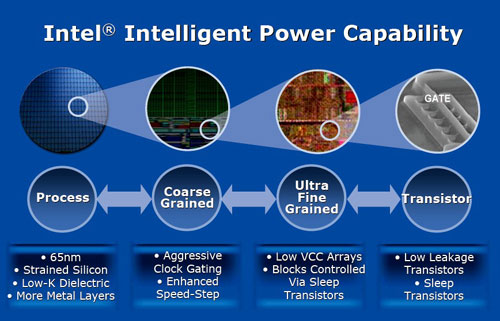
The wattage monitoring unit we used reads power consumption at the wall plug. The values shown in the “Power Consumption” chart represent therefore total system consumption and not just CPU power consumption. In order to take other sources as much as possible out of the equation we switched from the power hungry 7900GTX to a fanless entry-level ATI Radeon X1300. This way the WD760GD “Raptor” hard disk drive remained the only other energy consumer in addition to chipset and CPU. We then measured the test systems’ wattage with both processor cores running at 100% load crunching two FAH (Folding @ Home) work units. FAH is heavily stressing the CPU. We found that the X6800 at default frequency and voltage is consuming 148 Watt. This is 47% less than a Pentium D 955XE and around 30% less power than a FX-62. Under 100% load and using the manufacturer-provided retail heatsinks the X6800 was running at 2.93 GHz around 8 C cooler than the 955XE at 3.45 GHz. The X6800 was running around 3 C cooler than the FX-62 at default voltage and default speed of 2.80 GHz.
Finally we wanted to see how much energy Conroe is consuming when running at the same frequency as the 955XE. For that purpose the X6800 was overclocked to 3520 MHz, for good measure slightly above the default frequency of the 955XE. The system power consumption was measured as before with both systems running at 100% load crunching two FAH work units. We measured an energy consumption of 166 Watt for the X6800. This is almost 43% less than what the 955XE was consuming. It shows that the “Core” micro-architecture is far more energy efficient than the “NetBurst” design.
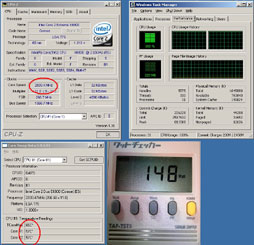 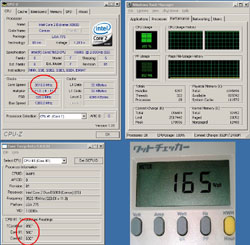
Temperature and Power Consumption at 2933MHz (left) and 3519MHz (right)

The drastic power and heat reduction Intel has achieved with their new architecture is very good news, because the excessively high Pentium 4 power consumption had become a major headache for PC users in terms of heat output, noisy fans and the monthly utility bill.
Overclocking:
In our earlier Presler article we have demonstrated that the 65nm based dual core 9xx series is great overclocking material. In particular the lower clocked versions, like the 920, have huge frequency headroom. We could run an aircooled 920 at 4.2 GHz; that is 50% above default. Many users report that their Pentium D 920 are running air-cooled at 4.00 GHz or higher. The reason for this huge headroom is obviously Intel’s high yielding 65nm production technology. It’s reducing the temperature and current leakage that troubled 90nm based processors like Prescott and Smithfield. Conroe is of course produced with 65nm technology as well, and therefore we expected similarly good overclocking results to the 65nm Presler based 9xx series.
The X6800 comes with an open multiplier. The possibility to raise or lower the multiplier can make overclocking easier. Regular Core 2 Duo CPUs have a locked multiplier and can be overclocked only by increasing the FSB frequency. For a realistic evaluation of Conroe’s overclocking potential we decided to use the E6700 instead of the X6800, because the latter will be priced out of reach for most users. We also intentionally did not use a more sophisticated cooling solution, like watercooling or phase-change. Just the regular retail Intel heatsink and fan provided with the boxed product had to do. The idea was to demonstrate what a user without any additional equipment can achieve with Conroe “out of the box”.
Before we could indulge ourselves in the pleasures of overclocking we had to solve a little problem though: The Intel 975BXB motherboard has a full array of overclocking features, such as a 50% FSB frequency override, voltage adjustments for CPU, MCH and FSB, and few things more. These BIOS features however are only available if the 975XBX is used with a Pentium D or Core 2 Duo “Extreme” processor. Intel started this product policy some time ago with the 955XBK motherboard. If the 955XBK and the 975XBX are used with a regular, that is “non-extreme” CPU, all voltage adjustments are hidden. We tried it this way, and found that without the support of additional voltage the E6700 went up from the default frequency of 10 x 266 MHz = 2.66 GHz to around 10 x 330 MHz = 3.30 GHz.
This is not bad at all, but we assumed that more is possible, and resorted to a slight modification of the 975XBX to gain access to the BIOS voltage options. Unlike the boxed retail 975XBX motherboard, engineering samples come for evaluation purposes with an additional “OC Debug” jumper. When closing this jumper the BIOS gives access to the full range of overclocking tools regardless of what CPU is used. Unfortunately our retail board did not have this jumper installed. But even for an inexperienced user it is quite easy to connect the 2 solder points either by solder or conductive fluid. After the 2 points are connected the full range of overclocking features is available. It’s regrettable that Intel is trying to reserve the overclocking tools for the Extreme Editions only, because in terms of features, performance and stability the 975XBX is an excellent product for a very reasonable price.
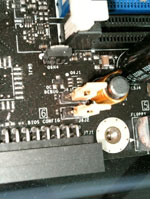 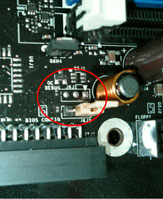 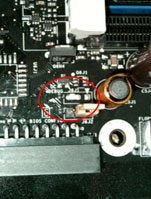
The "OC Debug" jumper - on ES board (left), missing on retail board (center), and soldered (right)
|
|
Advertisement:
All original content copyright James Rolfe.
All rights reserved. No reproduction allowed without written permission.
Interested in advertising on OCAU? Contact us for info.
|

|


